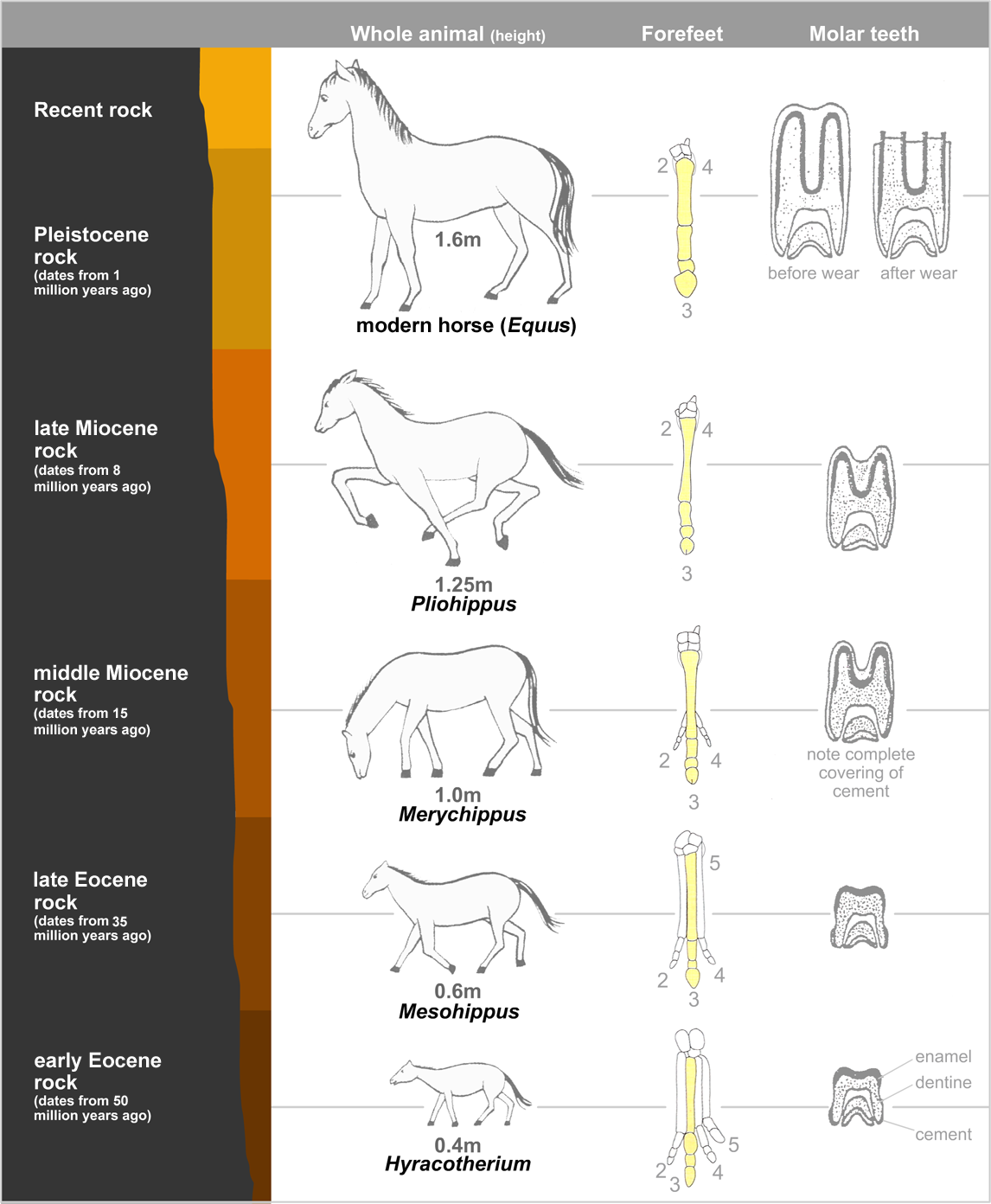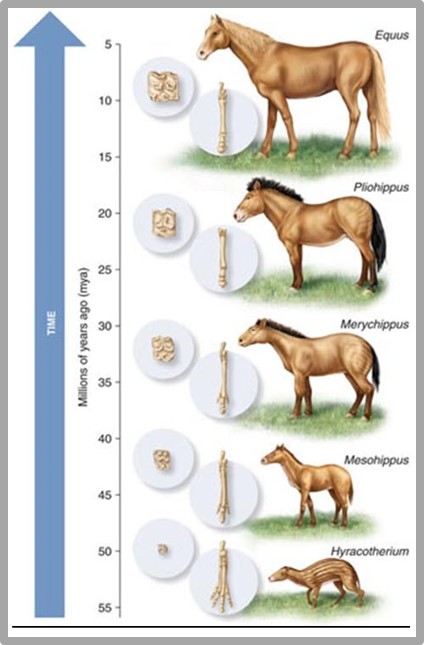Describe What Fossils Reveal About the Evolution of the Horse
Thomas Huxley an early advocate of Darwinian evolution visited the United States in 1876 on a lecture tourHuxley had planned to talk about evidence for evolution based on a fragmentary sequence of fossil horses from Europe. Using these fossils scientists have been able to reconstruct a large branching family tree for horses and their now-extinct relatives.

9 3 Evidence For Evolution Biology Libretexts
They were about the size of a fox and they had four long toes.
. Other evidence shows they lived in wooded marshlands where they probably ate soft leaves. What are vestigial structures. The evolution of modern horses Equus is best described as a.
The lineage that led to modern horses Equus grew taller over time from the 04 m Hyracotherium in early Eocene to the 16 m Equus. Autapomorphic giantism autapomorphic nanism phyletic giantism. With a fossil record.
It shows that over 50 million years the horse evolved from a dog-sized creature that lived in rainforests into an. The sequence of horse fossils that Marsh described and that TH. America Mostly grazers Mixed feeders Mostly browsers Old World.
In this paper we describe four different kinds of body-size evolution. Paleozoologists have been able to piece together a more complete outline of the evolutionary lineage of the modern horse than of any other animal. Other evidence shows they lived in wooded marshlands where they probably ate soft leaves.
The Eocene Palaeotherium Cuvier 1825 Anchitherium. Fossils have been found in US states such as Colorado and Nebraska as well as in Canada. The horse series has long been a showcase of evolution.
Describe what fossils reveal about the evolution of the horse. Describe what fossils reveal about the evolution of the horse. Much of this evolution took.
Describe the type of mutations that affect evolution. Increase in size reduction in the number of hooves loss of the footpads lengthening of the legs fusion of the independent bones of the lower legs elongation of the muzzle increase in the size and complexity of the brain. They were about the size of a fox and they had four long toes.
America 10 15 20 25 30 35 40 45 50 55 N. What are the forces of evolution. They lived in wooded marshlands and probably ate soft leaves.
Scientists have a fairly complete fossil record for the evolution of the horse. From the fossils they can learn what extinct ancient organisms were like and how they lived. During the early Eocene there appeared the first ancestral horse a hoofed browsing mammal designated correctly as Hyracotherium but more commonly called Eohippus the dawn horse Fossils of Eohippus which have been found in both North America and Europe show an animal that stood 42 to 5 hands about 427 to 508 cm or 168 to 20 inches high diminutive by.
This article addresses some of the current problems and concludes that the. For example some of the best-studied fossils are of the horse lineage. Habilis in human evolution.
Describe what fossils reveal about the evolution of the horse. Fossils reveal that the earliest horses were about the size of a fox and had four long toes. They study the fossils of animals they find and compare them to common ancestors.
Theyre seen as the link between Eohippus-like horses and the modern horse. Briefly describe at least two theories that attempt to explain the cause of. Parahippus lived around the end of this time period about 20 million years ago.
The first fossils to be recognized as members of the horse lineage were found in Europe. Through time the climate became drier and grasslands slowly replaced the marshes. They compare to the anatomy embryos and DNA describe what fossils reveal about the evolution of the horse they show they became taller evolved a single large toe hoof and their teeth back become longer and covered with cement.
Describe the importance of H. The evolution of the horse a mammal of the family Equidae occurred over a geologic time scale of 50 million years transforming the small dog-sized forest-dwelling Eohippus into the modern horse. The oldest horse fossils show what the earliest horses were like.
1 Creationists have various opinions on whether the horse series is in fact made up of different created kinds. The horse lineage discovered from fossil evidence shows how horses have evolved from their now-extinct Mesophippus to now-extinct Merychippus to now-extinct. The fossil record provides snapshots of the past which when assembled illustrate a panorama of evolutionary change over the past 35 billion years.
A study of fossil horses reveals at. Through time the climate became drier and grasslands slowly replaced the marshes. The line leading from Eohippus to the modern horse exhibits the following evolutionary trends.
Later fossils show that horses changed as well. It also shows that the bones of its hands fused together to create more streamlined and efficient tools for running they also got taller to allow for better vision while grazing. The fossil record reveals how horses evolved.
The Evolution of Horses from Eohippus to the American Zebra. The evolution of the horse a mammal of the family Equidae occurred over a geologic time scale of 50 million years transforming the small dog-sized forest-dwelling Eohippus into the modern horsePaleozoologists have been able to piece together a more complete outline of the. How did the Grants know that evolution had occurred.
The oldest horse fossils show what the earliest horses were like. One of Huxleys first stops was at Yale where he studied the fossil horse collection assembled by the paleontologist O. What factors caused the short-term evolution the Grants witnessed.
- Fossil records of the horse show that it was once browsing herbivore rather than the now grazing one. This lineage also developed longer molar teeth and the degeneration of the outer phalanges on the feet. The picture may be smudged in places and has bits missing but fossil evidence clearly shows that life is very very old and has changed over time through evolution.
Huxley popularized was a striking example of evolution taking place in a single lineage. Describe what fossils reveal about the evolution of the horse. But in reality this series is the best argument that can be presented against evolution from the fossil record.
Later fossils show that horses changed as well. Here one could see the fossil species Eohippus transformed into an almost totally different-looking and very familiar descendent Equus through a series of clear intermediates. Fossils are a window into the past.
The Fossil Record For The Evolution Of Horses Used To Be Cited As A Good Example Of Evolution Because Of Many Intermediate Species Why Isn T It Used Anymore Quora


No comments for "Describe What Fossils Reveal About the Evolution of the Horse"
Post a Comment